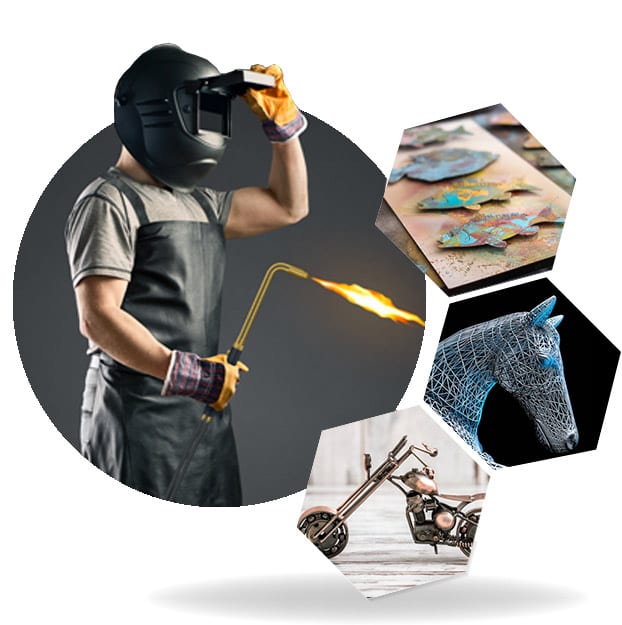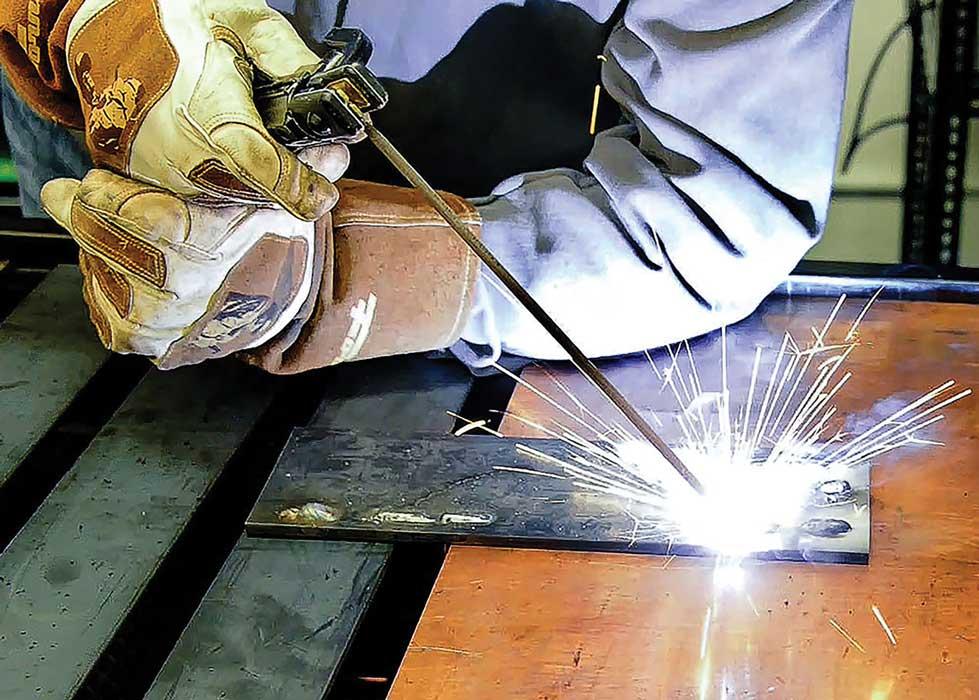All Regarding Welding: Secret Insights Into Techniques and Ideal Practices for Success
Welding includes a range of strategies, each suited for certain materials and applications. Recognizing these approaches, such as GMAW, SMAW, and TIG, is essential for achieving ideal results. The best tools and safety and security techniques can not be ignored. As prep work and fixing play important duties in the welding process, mastering these components can considerably boost the high quality of the end product. What are the vital factors that assure a successful weld?
Recognizing Various Welding Techniques
Welding strategies include a variety of approaches, each suited to specific applications and products. Among one of the most typical methods are Gas Steel Arc Welding (GMAW), Protected Steel Arc Welding (SMAW), and Tungsten Inert Gas Welding (TIG) GMAW, additionally understood as MIG welding, is prominent for its rate and adaptability, making it excellent for thin products. SMAW, or stick welding, is favored for its simpleness and performance in outside environments, especially with thicker metals. TIG welding uses accuracy and control, making it suitable for detailed work and non-ferrous steels (Welding). Each method has its one-of-a-kind advantages and considerations, allowing welders to pick the very best method based on the task's requirements, material kind, and desired results. Understanding these methods is important for effective welding
Essential Welding Devices and Devices
While numerous welding methods need specific skills, the ideal equipment and tools are equally essential for accomplishing quality results. Crucial welding tools consists of welding devices, which differ depending upon the technique-- such as MIG, TIG, or stick welding. Safety gear, consisting of safety helmets, handwear covers, and aprons, assurances security and comfort throughout the procedure. On top of that, fixtures and clamps assist protect materials in place, guaranteeing precision in welds. Consumables like welding poles, cord, and securing gas are additionally vital elements that influence the high quality of the weld. Moreover, devices such as cutters and mills assist in surface area prep work and post-weld completing, adding to a specialist end result. Investing in premium equipment inevitably improves the efficiency and efficiency of welding projects.
Safety Practices in Welding
Correct security practices are crucial in the welding market to shield workers from prospective hazards. Welders need to use appropriate individual protective devices (PPE), including safety helmets with proper shading, handwear covers, and flame-resistant clothing. Ample air flow is vital to lower exposure to hazardous fumes and gases created throughout the welding process. In addition, workers should be learnt the proper handling of welding equipment to avoid accidents. Fire precaution, such as maintaining combustible products away from the welding location and having fire extinguishers readily offered, are required. Normal evaluations of devices and work areas can aid identify potential risks before they lead to mishaps. By sticking to these safety methods, welders can develop a safer working atmosphere and lessen threats associated with their trade.
Readying Products for Welding
Preparing products for welding is an essential step that substantially influences the high quality and honesty of the end product (Montana Mobile Welding and Repair Fabrication). Correct prep work entails cleansing the surfaces to remove contaminants such as corrosion, oil, and dirt, which can compromise the weld. Techniques such as grinding, sanding, or using solvents are typically employed to achieve a clean surface area. Furthermore, making certain that the products mesh snugly is important; gaps can result in weak welds. It's additionally crucial to think about the positioning and positioning of the elements, as this will certainly impact the ease of welding and the last outcome. Picking the proper filler material and making sure compatibility with the base steels is crucial for accomplishing solid, resilient welds.
Tips for Achieving High-Quality Welds
Attaining high-grade welds requires focus to detail and adherence to finest methods throughout the welding procedure. Proper joint prep work is vital, ensuring surfaces are totally free and tidy from contaminants. Choosing the suitable filler material and welding strategy based on the base steels is important for optimal bonding. Maintaining constant traveling rate and angle while welding can advertise and protect against flaws uniformity. Furthermore, controlling warm input is important; extreme warm can bring about bending and weakened joints. On a regular basis checking the welds throughout the process permits for prompt modifications if essential. Employing appropriate post-weld treatments, such as cleansing and stress relief, can boost the toughness and stability of the weld, ultimately ensuring an effective end result.
Troubleshooting Usual Welding Issues
Welding commonly offers obstacles that can influence the quality and honesty of the end home product. Usual problems such as porosity, inconsistent weld beads, and getting too hot can occur, each requiring certain troubleshooting strategies. Recognizing these troubles is necessary for welders to improve their skills and attain optimal results.
Porosity Issues Clarified
Although porosity can typically be neglected, it stays an essential problem in welding that can compromise the honesty of an ended up item. Porosity refers to the visibility of little gas pockets within the weld bead, which can lead and compromise the joint to early failing. This issue generally arises from pollutants, moisture, or improper protecting gas insurance coverage during the welding procedure. To alleviate porosity, welders must validate that the base materials are clean and completely dry, make use of suitable shielding gases, and maintain constant welding specifications. Frequently checking the devices and atmosphere can additionally help recognize prospective concerns prior to they materialize in the weld. Attending to porosity efficiently is essential for attaining strong, long lasting welds that meet top quality requirements.

Irregular Weld Beads
Irregular weld beads can considerably influence the high quality and strength of an ended up product. Various aspects add to this problem, consisting of incorrect traveling speed, wrong amperage settings, and inconsistent electrode angles. When the welder relocates also swiftly, a grain may show up narrow and do not have penetration, while relocating as well gradually can create too much build-up. Additionally, using the incorrect amperage can lead to either undercutting or too much spatter, both of which concession weld integrity. The welder's strategy, such as irregular torch activity, can also result in irregular bead look. To minimize these troubles, welders should concentrate on keeping consistent, controlled movements and making sure correct tools settings to attain harmony in their welds. Uniformity is key to achieving trusted arcweld and solid welds.
Overheating and Bending Issues
Extreme warm throughout the welding procedure can cause significant overheating and contorting issues, affecting the structural stability of the workpiece. These troubles commonly materialize as distortion, which can endanger positioning and fit-up, making additional setting up testing. Aspects adding to overheating include the choice of welding parameters, such as voltage and take a trip speed, along with the sort of product being bonded. To alleviate these issues, welders must preserve regular traveling speed and suitable warmth input while checking the work surface temperature. Furthermore, pre-heating or post-weld warmth treatment can help relieve stresses triggered by fast air conditioning - Welding. Normal assessment and adherence to best techniques are crucial in preventing overheating and ensuring the long life and integrity of bonded frameworks
Regularly Asked Inquiries
What Are the Career Opportunities in the Welding Industry?
The welding industry uses diverse career possibilities, including settings as welders, instructors, designers, and inspectors. Professionals can work in manufacturing, construction, aerospace, and vehicle fields, gaining from strong demand and affordable wages in different roles.
Just How Can I Enhance My Welding Speed Without Compromising Quality?
To enhance welding rate without compromising quality, one need to exercise effective techniques, preserve devices, maximize settings, and boost hand-eye coordination. Routine training and looking for responses can additionally substantially contribute to attaining much faster, high-quality welds.
What Qualifications Are Readily Available for Welders?
Countless certifications exist for welders, consisting of those from the American Welding Society (AWS), the National Center for Building And Construction Education and Study (NCCER), and numerous industry-specific organizations. These qualifications enhance employability and show skill efficiency.
Just How Does Welding Affect the Features of Metals?
Welding influences the properties of metals by altering their go to the website microstructure, which can lead to modifications in solidity, ductility, and toughness. Heat input and cooling rates throughout the procedure significantly influence these material attributes.
Can I Weld Dissimilar Metals Together?
